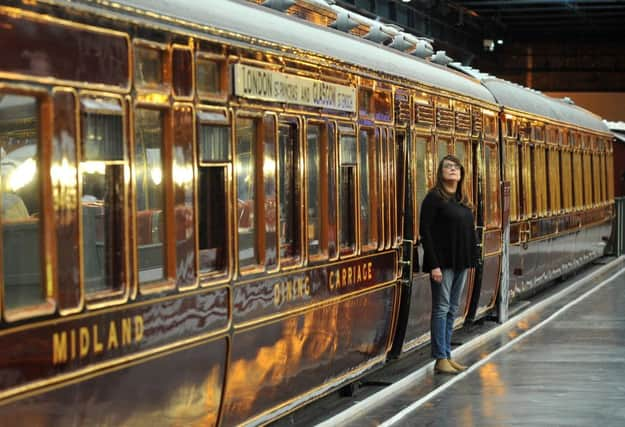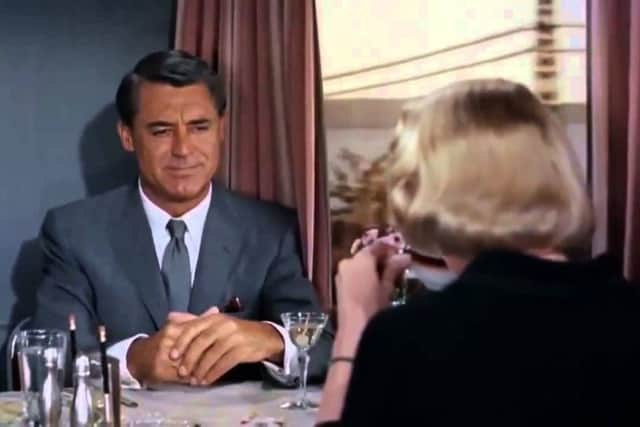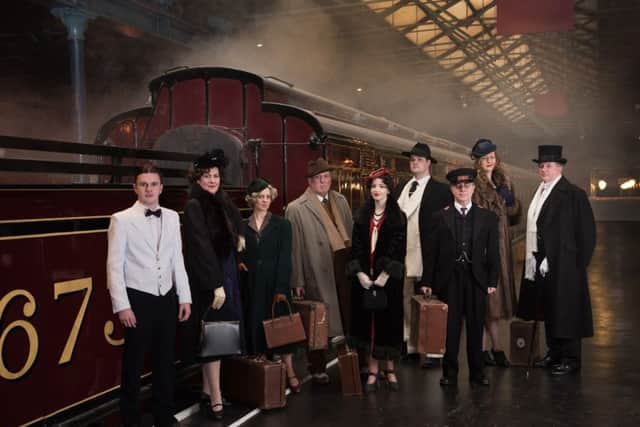Why the trains in York are murder these days


One of the train’s vintage coaches is the setting for the crime at the heart of The Missing Passenger, a new “exhibition trail” in the museum’s Station Hall. When it’s launched on March 23, visitors will be invited to solve the murder, which has eight suspects, as many motives and alibis, and some carefully scattered clues. Whodunnit? You decide. Discover your inner Poirot.
The trail is a major feature of the museum’s forthcoming Mystery on the Rails season, which investigates why trains have had such a special role in mystery and detective fiction, both in books and on screen.
Advertisement
Hide AdAdvertisement
Hide AdCelebrated examples include Strangers on a Train, The 39 Steps, The Lady Vanishes, North by Northwest, From Russia With Love and, more recently, The Girl on the Train.


But it’s Agatha Christie who tops the murder-on-the-move list, thanks to The Mystery of the Blue Train, 4.50 from Paddington, The ABC Murders and, most famously, Murder on the Orient Express.
There’s a strong whiff of the Orient Express story in The Missing Passenger. Set in the 1930s on an Inverness-London sleeper, it centres on the murder of a theatrical agent and has a roll call of suspects including a countess and a film star (though no moustachio-twirling Poirot, mon ami).
This “celebration of the golden age of crime novels and rail travel”, using objects from the museum collection, has been devised by Geraldine Pilgrim, a London-based director, designer and installation artist who works in both theatre and the visual arts.
Advertisement
Hide AdAdvertisement
Hide Ad“I absolutely love trains,” she says. “You’re in a world that’s completely self-contained, a little bubble where anything is possible. And I love Agatha Christie. She’s hugely admired in Europe but people in this country sometimes write her off. I find that distressing. Her skill with plots is incredible – the depth of thought that went into The Mousetrap...”


Radiating energy and enthusiasm, Pilgrim – described by one leading theatre critic as “a visual magician” – walks me up and down the platform, talking about the murder suspects, who appear only in photographs. They’re modelled by York-based volunteers, ranging in age from 18 to 80+, but no actual ‘live’ (or dead) performers are involved in the trail.
We gaze through the windows of a dining car and a sleeping compartment, taking in clues. “There’s a series of puzzles and clues; people will put the jigsaw together to decide who did it,” she says. “That table will be the murder scene.” Very messy on a crisp white tablecloth.
The Mystery on the Rails season will also feature dissections of real crimes involving trains, sessions with a crime writer and “a chance to join forces with British Transport Police”.
Advertisement
Hide AdAdvertisement
Hide AdIt reflects a new approach by the National Railway Museum, very different from the fact-based world which often preoccupies hard-core rail enthusiasts – like the men happily browsing the museum shop’s copies of Seventies Spotting Days Around the London Midland Region, Classic 55 Deltics from the Final Years to Preservation and The Railway Goods Shed and Warehouse in England.


“A lot of our visitors are interested in history and heritage, not specifically trains,” says Amy Banks, head of exhibitions and design. “We get a lot of feedback about wanting to do something more active and participatory, not just looking.
“So we’ve been trying to work more creatively and explore the subject of railways more broadly. And the Station Hall seemed to be a set in its own right, where we can do something less static and more playful.”
I ask her colleagues Karen Baker and Ellen Tait, both heavily involved in the project, why they think railways have appealed to crime writers so much.
Advertisement
Hide AdAdvertisement
Hide AdIdeas come thick and fast. There’s the way seemingly random strangers can be “trapped” together in moving carriages, creating tension. One of them may be a murderer; more tension.


Compartments are public spaces that can feel private, putting people off their guard. The hustle and bustle of stations gives criminals the opportunity for a quick getaway by disappearing into the crowd. Then there’s the romance and nostalgia of vintage rail travel (witness the restored Flying Scotsman’s astonishing success).
And for writers, train travel is a convenient structural device. Set routes and precise timetables allow them (and fictional murderers) to plan crimes meticulously.
Geraldine Pilgrim has taken a similar approach herself when plotting events in The Missing Passenger. “I’ve worked out an exact rail timetable that could have happened,” she says. “And I’ve taken many known concepts of detective novels. People who read them will recognise the archetypes.”
Advertisement
Hide AdAdvertisement
Hide AdShe specialises in creating “site-specific” installations and performances, experimental work often exploring the history and atmosphere of particular buildings and landscapes. Memories – real and imagined – play a big part. “Quite often I think of a landscape dreaming of its own past and I want to bring it to life.”
Her many commissions – including projects for English Heritage and the National Trust – have included working in empty office blocks, a psychiatric hospital, Tattershall Castle in Lincolnshire, swimming baths, care homes, Harewood House (for the centenary of the Girl Guides), Brighton Pavilion, a disused tobacco factory in Madrid, and two decaying hotels – London’s St Pancras Hotel and the Midland Hotel in Morecambe – before their lavish restorations.
“I have what I call ‘the Auntie Minnie test’,” she says. “My family would come and see my early work and my dad thought it was quite strange. But my Auntie Minnie always understood it. If she ever queried anything, I’d say: ‘That’s a very good point.’ I don’t want my work to be obscure. I want people who didn’t go to art school or come from a non-theatre background to understand it.”
She comes from such a background herself, though at a slight remove. Her grandparents ran the Pilgrim Players, a London-based theatre company touring Shakespeare around parks and stately homes – “and my uncle was in one of the first film adverts in the Edwardian era – for Bovril.”
Advertisement
Hide AdAdvertisement
Hide AdIn the late 1970s, she was a student in Leeds Polytechnic’s innovative Fine Art Department and remembers it as “an extraordinary time”. Her tutors included Roland Miller, the dependably off-the-wall Sheffield-based performance artist. In the 1990s, when Sheffield was controversially spending vast sums on hosting the World Student Games, he staged an Alternative Student Games in a local park. The events included “simulated swimming” and horseshoe-throwing. To save money, the horseshoes were imaginary.
“I was very privileged to be of a generation when education was free and you could experiment; everything now is compartmentalised,” says Pilgrim. “But it was tough; you had to be really good. Out of 40 students there were 36 men and four women and all the tutors were male. But there was no sexism.”
Over the years she has worked in alternative theatre and as a theatre designer – including (unlikely as it sounds) designing South Pacific at the Sheffield Crucible. “Theatres to me are fantastic neutral spaces that are there to be filled with people’s imagination...”
She hurries off to a meeting and I catch a train home. The man sitting next to me prattles inexhaustibly to a colleague on his mobile phone.
Advertisement
Hide AdAdvertisement
Hide Ad“I don’t think anyone with a web account should be chair... other people might have access to it... look at the ‘add to contacts’ inbox... send me a screenshot... there’s a hyperlink...do they have a spreadsheet?... I’m losing you... I hate this phone...”
Me too. How can I stop him? Whodunnit? Me, m’lud. I nearly dunnit.
• The Missing Passenger is part of the Mystery on the Rails season, which runs from March 23 to September 3 at the National Railway Museum, York (0844 815 3139,nrm.org.uk). Free; no booking required.